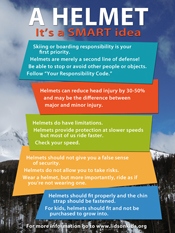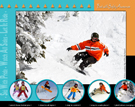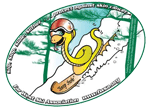Helmets are a viable piece of equipment for skiers and snowboarders, just as they are for any sport or profession where one might encounter a bump on the head. The bottom line is it’s a matter of personal choice whether to wear one, or not. There is a wide variety of helmets available. If you choose to wear a helmet, it is important that it fits properly, is comfortable, and offers the appropriate level of protection for the activity of choice.
How to Choose a Helmet
All helmets bearing a label or sticker certifying compliance with industry standards don't necessarily protect your head equally. Whether you choose a short-shell or full-shell helmet, make sure it fits properly. Some helmets come in kids' sizes or adult sizes only. On some helmets, sliding or removable vent covers and removable earflaps let you emphasize warmth or ventilation.
Put the helmet on.
It should be snug, but not tight, all the way around your head. Bring your goggles with you when shopping. Make sure there are no big gaps between goggles and helmet that leave your forehead and temples exposed.
If you're buying a helmet for a child, get one that fits now, not one to “grow into.” If you must buy a helmet without trying it on, make sure you can return or exchange it.
Fine-tune the helmet's fit.
Adjust the straps so that the helmet's front edge is no more than an inch or so above your eyebrows. Then push on its front, back, and sides. If it shifts around and you can push the front or back up by more than about an inch, further tighten the straps. Adjusting the straps can take time, but you shouldn't have to do it more than once. You can also check if the helmet comes with extra pads that you can insert to improve the fit. If the helmet is still loose, find another.
Don't buy by price.
Typically, you'll spend $90 to $150 for one of the top helmets. Price bears little relationship to performance. Check out the Bolle deal being offered by the National Ski Council Federation. Click on Member Benefits. Enter "skiclub" for User Name and "member" for Password.
Wear the right helmet for the slopes.
Don't try saving money by wearing a bike helmet on the slopes. A bike helmet is better than nothing, but a ski helmet covers more of your head, is typically warmer, and has a shell designed to protect against penetration by sharp edges like those on skis and snowboards. A run-in between head and ski, board, or tree happens rarely, but if it does, you'll want a ski helmet as protection.
Ski With Pride • Watch All Sides • Let It Ride
First with Safety Awareness



![]()








